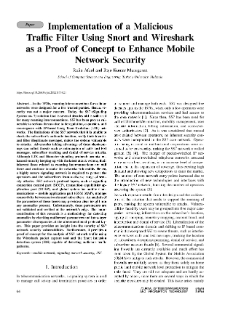Instytut Łączności – Państwowy Instytut Badawczy contains 2 324 digital objects
Object
Title: Implementation of a Malicious Traffic Filter Using Snort and Wireshark as a Proof of Concept to Enhance Mobile Network Security, Journal of Telecommunications and Information Technology, 2022, nr 1
Description:
Publisher:
Instytut Łączności - Państwowy Instytut Badawczy
Format:
Resource Identifier:
ISSN 1509-4553, on-line: ISSN 1899-8852 ; oai:bc.itl.waw.pl:2216
Source:
Journal of Telecommunications and Information Technology
Language:
Rights Management:
Biblioteka Naukowa Instytutu Łączności
Object collections:
- Digital Library > Institute's Publications > Current Publications > Journal of Telecommunications and Information Technology (JTIT)
Last modified:
Mar 11, 2024
In our library since:
Apr 26, 2022
Number of object content hits:
64
All available object's versions:
https://bc.itl.waw.pl/publication/2522
Show description in RDF format:
Show description in OAI-PMH format:
Objects Similar
Obrocka, Anna
Niewiadomska-Szynkiewicz, Ewa Sikora, Andrzej
Salman, Omar Hussein Abdullah, Osamah Aal-Nouman, Mohammed I. Al-Shaikhli Noor Qusay A.
Zieliński, Andrzej Zieliński, Kazimierz
Voß, Stefan Schwarze, Silvia Nitsch, Ralf Wevering,Stefan Fricke, Matthias Heckwolf, Andrea Herber, Ralf
Manvi, Sunilkumar S. Basarkod, P. I.
Yoon Song, Ha
Bachran, Thomas Bongartz, Harald H.-J.

